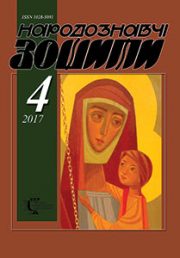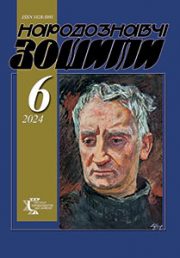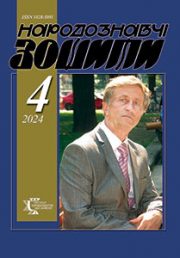The Ethnology Notebooks. 2019, 1 (145), 266—271
UDK 792.028028″1922/1933″(092)
DOI https://doi.org/10.15407/nz2019.01.266
BOIKO Tetiana
ORCID ID: https://orcid.org/0000-0001-6941-8868
Ph.D in History of Art,
Senior Research Fellow,
Kyiv National University of Culture and Art,
Department of directing and acting,
36, Yevhen Konovalets str., 01133, Kyiv, Ukraine
Contacts: e-mail: tetiana.boyko@gmail.com
Abstract. The purpose of the article is to highlight some of the aesthetic-artistic vectors of the acting art of the 1920’s and 1930’s and to expand the knowledge of Y. Hirniak’s work, in particular the theorizing of those episodes that are associated with the formation of a universal artist’s performing style.
Research methodology: the process researches provided a phenomenological (generalization of individual characteristics of the performing manner of Y. Hirniak), historical, comparative and comparative-typological methods designed to reveal the similarity and distinction between the phenomena of the theater of the 1920’s and 1930’s, to determine the genetic affinity, general and specific in their development.
The scientific novelty is in the derivation of new theoretical generalizations of the creative work of Y. Hirniak on the Berylsky stage. In particular, author’s attention was focused on the concepts of «reasonable harlequinade», which related the stage practice of the actor with director’s reflections Les Kurbas on the model of universal actor of that time.
Conclusions: one of the vectors of the directing practice of Les Kurbas was to find technological mechanisms for the formation of a universal actor. Y. Hirniak’s stage performance in «Berezil» reflected the effectiveness of these searches both in the sense of transforming the psychological states of the character, and purely technical means of creating an image. Accordingly, the professional formation of Y. Hirniak, to a large extent, was carried out according to the concepts of «reasonable harlekinady», because the artistʼs manner of acting was versatile and intellectual.
Keywords: «reasonable harlequin», universal actor, performance practice, Les Kurbas, director’s guides.
Received 27.01.2019
REFERENCES
Bachelis, T. (2007). Gamlet i Arlekin (Hamlet and Harlequin). Moskow: Agraf [in Russian].
Boboshko, Yu. (1987). Rezhyser Les Kurbas (Director Les Kurbas). Kyiv: Mystetstvo [in Ukrainian].
Veselovska, H. (1997). Yak narodzhuvavsia Arlekin (How was born Harlequin). Ukrainian theate, 2, 6—9. Kyiv [in Ukrainian].
Volytska, I. (2007). Kurbasova definition of creativity of the actor and the category of «prolongation». Kurbasov readings, 2, 82—93. Kyiv [in Ukrainian].
Hirniak, I. (1982). Memories. New York: Suchasnist [in Ukrainian].
Ermakova, N. (2008). Actor in terms of pedagogy: (from the practice of the Art Association «Berezil»). Ukrainian Theater, 2, 21—24. Kyiv [in Ukrainian].
Kornienko, N. (2007). Les Kurbas: rehearsal of the future. Kyiv: Lybid’ [in Ukrainian].
Kurbas, L. (1988). Berezil: From the Creative Heritage. Kyiv: Dnipro [in Ukrainian].
Les Kurbas: Articles and memories of Lesbas Kurbas. Literary heritage: (1987). (Compilation M.G. Labinskii, L.S. Tanyuk). Moskow: Iskusstvo [in Russian].
Meyerhold, Vs., & A. Fevralsky (Ed.). (1968). Articles. Letters. Speeches. Conversations: 2 parts. Part 1: (1891—1917). Moskow: Iskusstvo [in Russian].
Cherkashin, R. (1990). Master of tragigrotesque. Ukrainian Theater, 1, 4—17. Kyiv [in Ukrainian].
Shevchenko, N. (2003). «Intelligent Harlequin» — between the temple and the area: (to the science of acting transformation). Arcadia, 1, 49—52. Odesa [in Ukrainian].






